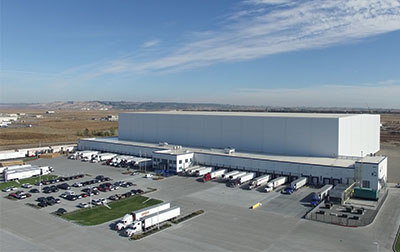Preferred Freezer Services
Richland, Wash.
Size: 380,000 square feet, 120 feet tall with 120,000 pallet positions
Products: Frozen French fries
Throughput: The facility holds 200 million pounds of product, handling 2 billion pounds a year, and turning inventory up to 10 times annually. Processes 700 pallets per hour
Shipping: The facility features 36 dock doors, including four dedicated to automatic trailer unloading
Shifts: 24 hours per day/5.5 days per week.
Employees: 120 employees
Read the full cover story on Preferred Freezer Services’ redesign here.
Preferred Freezer Services’s Richland, Wash., warehouse is one of the most automated facilities in North America. In fact, automation begins at the receiving dock, where 100 or more truckloads are automatically unloaded per day.
Receiving: The facility may receive as many as 170 deliveries a day, including an estimated 100 deliveries from three specific manufacturing sites that are part of a closed loop. In those instances, 53-foot long trailers have been outfitted with chain conveyor for automatic trailer unloading. Those trailers are received at four docks that have similarly been outfitted with chain conveyor that matches the chains on the truck. Once the trailer backs into a bay and plugs into the dock system, the truck is automatically leveled and the high-speed door is raised. Once an associate initiates the unloading process, a trailer can be automatically unloaded in about 2 minutes.
The remaining trucks are received at six conventional receiving docks and pallets are unloaded using lift trucks and are staged for putaway into the automated storage and retrieval system (AS/RS).
Storage: Pallets are inducted onto a pallet conveyor that feeds an overhead monorail system. Before that happens, they must pass a sizing and bar code read inspection to ensure they will work with the automation. Assuming the reads are correct, pallets are directed to one of several spurs for induction onto the monorail system.
The monorail system consists of 36 carts that travel around a 2,200-foot loop. Carts stop at an induction station on the pallet conveyor to automatically receive a pallet and then continue to one of nine induction stations for the three freezers. Pallets then enter a transition zone for the freezer to minimize temperature loss. Once inside, they are loaded onto a cart on an AS/RS crane.
Once the crane moves into position at the desired storage level, the cart lifts the pallet up and moves onto a rail that it follows to a storage location. The carts are equipped with a super capacitor that allows them to work in a freezer environment. They can be recharged in less than 10 seconds and travel 300 feet before the next charge.
Following putaway, the crane can retrieve the next pallet needed from storage and drop it off on the conveyor in the transition area. In all, the AS/RS is handling 250 pallets per hour in and out of the system.
Packing and shipping: Pallets are delivered from the freezer to a pallet build area, where mixed SKU pallets are manually built for truckload shipments. Full loads on slip sheets are loaded by clamp trucks onto rail cars, and service three cars at a time. All told, the facility ships approximately 150 truckloads and 12 rail cars per day.
System suppliers
- System Design, WMS & Middleware: Preferred Freezer Systems
- AS/RS and Pallet Conveyor: Dematic
- AS/RS Shuttle/Carts: Authoma Group
- Monorail: Eisenmann
- Pallets: Millwood
- Pallet Racks: Frazier Industrial
- High-Speed Doors: Assa Abloy Entrance Systems (Albany)
- Lift Trucks: Crown
- Slipsheets & Clamp Attachments: Cascade
- Bar Code Scanning: Honeywell (Thor)
- Stretch Wrap: Lantech
- Insulated Panels: Metl-Span
Article topics








